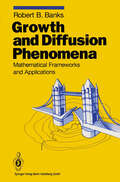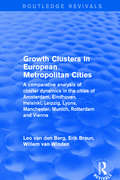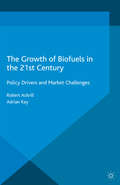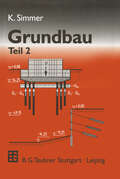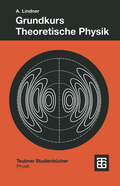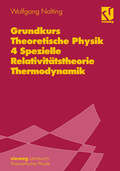- Table View
- List View
Growth and Diffusion Phenomena: Mathematical Frameworks and Applications (Texts in Applied Mathematics #14)
by Robert B. BanksDiffusion and growth phenomena abound in the real world surrounding us. Someexamples: growth of the world's population, growth rates of humans, public interest in news events, growth and decline of central city populations, pollution of rivers, adoption of agricultural innovations, and spreading of epidemics and migration of insects. These and numerous other phenomena are illustrations of typical growth and diffusion problems confronted in many branches of the physical, biological and social sciences as well as in various areas of agriculture, business, education, engineering medicine and public health. The book presents a large number of mathematical models to provide frameworks forthe analysis and display of many of these. The models developed and utilizedcommence with relatively simple exponential, logistic and normal distribution functions. Considerable attention is given to time dependent growth coefficients and carrying capacities. The topics of discrete and distributed time delays, spatial-temporal diffusion and diffusion with reaction are examined. Throughout the book there are a great many numerical examples. In addition and most importantly, there are more than 50 in-depth "illustrations" of the application of a particular framework ormodel based on real world problems. These examples provide the reader with an appreciation of the intrinsic nature of the phenomena involved. They address mainly readers from the physical, biological, and social sciences, as the only mathematical background assumed is elementary calculus. Methods are developed as required, and the reader can thus acquire useful tools for planning, analyzing, designing,and evaluating studies of growth transfer and diffusion phenomena. The book draws on the author's own hands-on experience in problems of environmental diffusion and dispersion, as well as in technology transfer and innovation diffusion.
Growth and Form: Nonlinear Aspects (Nato Science Series B: #276)
by M. Ben Amar P. Pelcé P. TabelingGrowth and Fonn is the title of a famous book written by D' Arcy Thomson at the beginning of the century. It relates a large number of problems of shapes of bodies either in the physical world or the biological realm. Keywords in this field are shapes, spirals, growth law, gravity field, surface tension, scaling laws, diffusion and mechanical efficiency. This field is the source of a considerable amount of work, even today, and this conference was a place where some of this work was discussed. Except for a few contributions with biophysical inspiration, the main part of the conference was devoted to physical problems related to growth and fonn and especially to the problem of the motion of interfaces under various nonequilibrium conditions. Even with this restriction, this field is huge, from the more applied area (combustion, metallurgy) to the more fundamental (singularities in the complex plane, solvability conditions). One day, at dinner time, in a restaurant with a good view of the corsica sea, W. Kurz from Lausanne told us about teleferique cables and the kind of material which was necessary to build them. Considering the important abyss between this kind of concept and for instance, the huge fonnalism involving Green functions used to find operating points for dendritic growth, we immediatelty had the giggles for five minutes. This large domain was the occasion to confront many scientists from different areas (physicists, applied mathematicians, specialists of combustion, metallurgists and geologists).
Growth and Innovation of Competitive Regions: The Role of Internal and External Connections (Advances in Spatial Science)
by Ugo Fratesi Lanfranco SennTime Time b a Space Space Time Time c d Space Space Fig. 1 Different possible scales for growth and innovation analyses spatial dimension, the sectoral dimension and the time dimension are represented. In Fig. 1a, regional developmentanalyses are revealed, where the economyis sliced vertically into regions and their dynamics are investigated. The study of the evolution of industries, typical of evolutionary industrial e- nomics, is represented in Fig. 1b, where the economy is divided horizontally into sectoral slices. This approach has progressed considerably in recent years (see Malerba 2006, for a recent survey). Modi?cations of industries have important spatial implications, which however are not normally at the core of these ana- ses even though spatial patterns of innovation differ greatly from sector to sector (Breschi 2000). Our approach operates in the manner of Fig. 1a and we will focus on regions, extending the analysis to industries only where this is regionally and structurally relevant. Hence, the approach in the book belongs to the tradition of regional development theories, but, in contrast to the more traditional analyses, we will not consider the region as an economic unit per se. Rather, interactions between and within regions are very relevant to the performance of individual regions in an integrated world and will be at the core of the analyses of the following chapters.
Growth Clusters in European Metropolitan Cities: A Comparative Analysis of Cluster Dynamics in the Cities of Amsterdam, Eindhoven, Helsinki, Leipzig, Lyons, Manchester, Munich, Rotterdam and Vienna (Routledge Revivals)
by Leo van Berg Erik BraunThis title was first published in 2001. Analyzing and comparing several growth clusters in nine European cities, this compelling volume examines the critical success factors that determine the economic development of urban regions.
Growth Clusters in European Metropolitan Cities: A Comparative Analysis of Cluster Dynamics in the Cities of Amsterdam, Eindhoven, Helsinki, Leipzig, Lyons, Manchester, Munich, Rotterdam and Vienna (Routledge Revivals)
by Leo van Berg Erik BraunThis title was first published in 2001. Analyzing and comparing several growth clusters in nine European cities, this compelling volume examines the critical success factors that determine the economic development of urban regions.
Growth, Dissolution and Pattern Formation in Geosystems
by Bjørn Jamtveit and Paul MeakinThis book is the proceedings of the 11th Kongsberg seminar, held at the Norwegian Mining Museum in the city of Kongsberg, about 70 km Southwest of Oslo. The Kongs berg district is known for numerous Permian vein deposits, rich in native silver. Mining activity in the area lasted for more than 300 years, finally ceasing in 1957. The first eight Kongsberg seminars, organized by professor Arne Bj0rlykke, now director of the Norwegian Geological Survey, were focused on ore-forming processes. These seminars have always been a meeting point for people with a variety of geological backgrounds. Since 1995, the Kongsberg seminars have focussed on geological processes, rather than on specific geological systems, and the selection of invited speakers has been strongly influenced by their interest in the dynamics of geological systems. In 1995 and 1996, various aspects of fluid flow and transport in rocks, were emphasized. The first "Kongsberg proceedings" (of the 1995 seminar) published by Chapman and Hall (Jamtveit and Yardley, 1997) contained 17 chapters dealing with a wide range of topics from field based studies of the effects of fluid flow in sedimentary and metamorphic rocks to computer simulations of flow in complex porous and fractured media. In 1997, the focus was changed to growth, and dissolution processes in geological systems.
Growth for Good: Reshaping Capitalism to Save Humanity from Climate Catastrophe
by Alessio TerziFrom the front lines of economics and policymaking, a compelling case that economic growth is a force for good and a blueprint for enrolling it in the fight against climate change. Economic growth is wrecking the planet. It’s the engine driving climate change, pollution, and the shrinking of natural spaces. To save the environment, will we have to shrink the economy? Might this even lead to a better society, especially in rich nations, helping us break free from a pointless obsession with material wealth that only benefits the few? Alessio Terzi takes these legitimate questions as a starting point for a riveting journey into the socioeconomic, evolutionary, and cultural origins of our need for growth. It’s an imperative, he argues, that we abandon at our own risk. Terzi ranges across centuries and diverse civilizations to show that focus on economic expansion is deeply interwoven with the human quest for happiness, well-being, and self-determination. Growth, he argues, is underpinned by core principles and dynamics behind the West’s rise to affluence. These include the positivism of the Enlightenment, the acceleration of science and technology and, ultimately, progress itself. Today growth contributes to the stability of liberal democracy, the peaceful conduct of international relations, and the very way our society is organized through capitalism. Abandoning growth would not only prove impractical, but would also sow chaos, exacerbating conflict within and among societies. This does not mean we have to choose between chaos and environmental destruction. Growth for Good presents a credible agenda to enroll capitalism in the fight against climate catastrophe. With the right policies and the help of engaged citizens, pioneering nations can set in motion a global decarbonization wave and in parallel create good jobs and a better, greener, healthier world.
Growth Management in Florida: Planning for Paradise
by Timothy S.Chapin Charles E. Connerly Harrison T. HigginsDespite its historical significance and its state-mandated comprehensive planning approach, the Florida growth management experiment has received only piecemeal attention from researchers. Drawing together contributions from national experts on land use planning and growth management, this volume assesses the outcomes of Florida‘s approach for managing growth. As Florida‘s approach is the most detailed system for managing growth in the United States, this book will be of great value to planners. The strengths and weaknesses of the state‘s approach are identified, providing insights into how to manage land use change in a state continuously inundated by growth. In evaluating the successes and failures of the Florida approach, planners and policy makers will gain insights into how to successfully implement growth management policies at both the state and local level.
Growth Management in Florida: Planning for Paradise
by Timothy S.Chapin Charles E. Connerly Harrison T. HigginsDespite its historical significance and its state-mandated comprehensive planning approach, the Florida growth management experiment has received only piecemeal attention from researchers. Drawing together contributions from national experts on land use planning and growth management, this volume assesses the outcomes of Florida‘s approach for managing growth. As Florida‘s approach is the most detailed system for managing growth in the United States, this book will be of great value to planners. The strengths and weaknesses of the state‘s approach are identified, providing insights into how to manage land use change in a state continuously inundated by growth. In evaluating the successes and failures of the Florida approach, planners and policy makers will gain insights into how to successfully implement growth management policies at both the state and local level.
Growth Management in the US: Between Theory and Practice
by Karina PallagstUrban sprawl is one of the key planning issues facing many US cities, leading to the creation and adoption of a variety of approaches to control growth. However, many growth management ideas do not align well with the growth-promoting planning traditions of the US, which historically have been dominated by the concerns of the market, the landowner and the developer. Illustrated by a study of the San Francisco Bay Area, this book puts forward an innovative theoretical approach to growth management, analyzing it as a tool for controlling land use expansion in the US. This region makes a particularly useful study as it has encountered long term growth pressures, complex land use demands and the application of a wide variety of growth management approaches over the past few decades. Using empirical, qualitative analysis, the book examines which growth management activities have actually been put into practice and which have proved successful and questions how such a planning approach functions in today‘s complex and multi-faceted planning paradigms. It concludes by stressing the different notions of interdependence in growth management: regional interdependence, interdependence between stakeholders and interdependence in planning theory.
Growth Management in the US: Between Theory and Practice
by Karina PallagstUrban sprawl is one of the key planning issues facing many US cities, leading to the creation and adoption of a variety of approaches to control growth. However, many growth management ideas do not align well with the growth-promoting planning traditions of the US, which historically have been dominated by the concerns of the market, the landowner and the developer. Illustrated by a study of the San Francisco Bay Area, this book puts forward an innovative theoretical approach to growth management, analyzing it as a tool for controlling land use expansion in the US. This region makes a particularly useful study as it has encountered long term growth pressures, complex land use demands and the application of a wide variety of growth management approaches over the past few decades. Using empirical, qualitative analysis, the book examines which growth management activities have actually been put into practice and which have proved successful and questions how such a planning approach functions in today‘s complex and multi-faceted planning paradigms. It concludes by stressing the different notions of interdependence in growth management: regional interdependence, interdependence between stakeholders and interdependence in planning theory.
The Growth of Biofuels in the 21st Century: Policy Drivers and Market Challenges (Energy, Climate and the Environment)
by R. Ackrill A. KayThis book provides a timely and insightful analysis of the expansion of biofuels production and use in recent years. Drawing on interviews with key policy insiders, Ackrill and Kay show how biofuels policies have been motivated by concerns over climate change, energy security and rural development.
The Growth of Italian Cooperatives: Innovation, Resilience and Social Responsibility (Routledge Studies in Social Enterprise & Social Innovation)
by Piero AmmiratoThe Italian Cooperative Sector is amongst the largest in the world comprising over 60,000 cooperatives from all sectors of the economy directly employing 1.3 million people. Cooperatives created close to 30 percent of new jobs in Italy between 2001 and 2011 demonstrating that democratic cooperative enterprises can successfully operate in a market economy combining economic success and social responsibility. These offer a viable alternative to profit maximising enterprises and an opportunity to create a more pluralist and democratic market economy. The Growth of Italian Cooperatives: Innovation, Resilience and Social Responsibility comprehensively explains how the Italian cooperative sector has managed to compete successfully in the global economy and to grow during the global financial crisis. This book will comprehensively explain how the Italian cooperative movement has managed to grow into a large successful network of cooperatives. It will examine the legislative framework and their unique business model that allows it to compete in the market as part of a network that includes central cooperative associations, financial and economic consortia, and financial companies. It will explore cooperative entrepreneurship through a discussion of the formation of cooperative groups, start-ups, worker-buyouts and the promotion of entirely new sectors such as the social services sector. Finally, The Growth of Italian Cooperatives examines how cooperatives have managed the GFC and how their behavior differs from private enterprises. It will also analyze the extent to which cooperatives compete while still uphold the key cooperative principles and fulfil their social responsibility. This book is an interdisciplinary study of cooperative development and is designed to inform members of the academic community, government, public policy makers and cooperative managers that are primarily interested in economic democracy, economics of the cooperative enterprise, cooperative networks and economic development, cooperative legislation, democratic governance, job creation programs, politics of inclusion and how wealth can be more equitably distributed.
The Growth of Italian Cooperatives: Innovation, Resilience and Social Responsibility (Routledge Studies in Social Enterprise & Social Innovation)
by Piero AmmiratoThe Italian Cooperative Sector is amongst the largest in the world comprising over 60,000 cooperatives from all sectors of the economy directly employing 1.3 million people. Cooperatives created close to 30 percent of new jobs in Italy between 2001 and 2011 demonstrating that democratic cooperative enterprises can successfully operate in a market economy combining economic success and social responsibility. These offer a viable alternative to profit maximising enterprises and an opportunity to create a more pluralist and democratic market economy. The Growth of Italian Cooperatives: Innovation, Resilience and Social Responsibility comprehensively explains how the Italian cooperative sector has managed to compete successfully in the global economy and to grow during the global financial crisis. This book will comprehensively explain how the Italian cooperative movement has managed to grow into a large successful network of cooperatives. It will examine the legislative framework and their unique business model that allows it to compete in the market as part of a network that includes central cooperative associations, financial and economic consortia, and financial companies. It will explore cooperative entrepreneurship through a discussion of the formation of cooperative groups, start-ups, worker-buyouts and the promotion of entirely new sectors such as the social services sector. Finally, The Growth of Italian Cooperatives examines how cooperatives have managed the GFC and how their behavior differs from private enterprises. It will also analyze the extent to which cooperatives compete while still uphold the key cooperative principles and fulfil their social responsibility. This book is an interdisciplinary study of cooperative development and is designed to inform members of the academic community, government, public policy makers and cooperative managers that are primarily interested in economic democracy, economics of the cooperative enterprise, cooperative networks and economic development, cooperative legislation, democratic governance, job creation programs, politics of inclusion and how wealth can be more equitably distributed.
Growth of the Southern Andes (Springer Earth System Sciences)
by Andrés Folguera Maximiliano Naipauer Lucía Sagripanti Matías C. Ghiglione Darío L. Orts Laura GiambiagiThis book presents recent findings on the structure and evolution of the Southern Andes. Through a detailed description of a series of orogenic segments reviewed by the different groups that have worked with structural and geophysical tools in each area over the last several years, it illustrates the diversity of mechanisms that have impacted strong orogenic gradients and consequently mountain morphology, from the southern Pampean flat subduction zone to the southern tip of the continent (33-56º S). The book also revises our conventional understanding of the source of the different Mesozoic to Cenozoic sections exhumed in the orogenic wedge, with the objective of discussing basin mechanisms through time. A final chapter discusses probable orogenic controls that have acted together in order to explain structure, the different deformational stages and intra-orogenic extensional collapses that affected the fold and thrust belt over time.
Growth Trends in European Forests: Studies from 12 Countries
by Heinrich Spiecker Kari Mielikäinen Michael Köhl Jens P. SkovsgaardThe European Forest Institute (EFI) has five Research and Development priority ar eas: forest sustainability, forestry and possible climate change, structural changes in markets for forest products and services, policy analysis, and forest sector informa tion services and research methodology. In the area of forest sustainability our most important activity has been the project "Growth trends of European forests", the re sults of which are presented in this book. The project was started in August 1993 under the leadership of Prof. Dr. Heinrich Spiecker from the University of Freiburg, Germany, and it is one of the first EFI's research projects after its establishment in 1993. The main purpose of the project was to analyse whether site productivity has changed in European forests during the last decades. While several forest growth studies have been published at local, re gional and national levels, this project has aimed at stimulating a joint effort in iden tifying and quantifying possible growth trends and their spatial and temporal extent at the European level. Debate on forest decline and possible climate change, as well as considerations re lated to the long term supply of wood underline the importance of this project, both from environmental and industrial points of view. Knowledge on possible changes in growth trends is vital for the sustainable management of forest ecosystems.
Grundbau: Teil 2 Baugruben und Gründungen
by Konrad SimmerGrundbau Teil 2 von Konrad Simmer beinhaltet die Bereiche Baugruben, Gründungen, Verankerungen und Stützbauwerke, Schutz und Abdichtung von Grundbauwerken gegen Grundwasser sowie die Sicherung von gefährdeten Bauten. Das Buch wendet sich in erster Linie an Studierende der Fachrichtung Bauingenieurwesen und Ingenieure in der Praxis. Teil 2 macht den Leser mit den Ausführungsmöglichkeiten der Baugrubensicherung, von Gründungen sowie von Stützbauwerken vertraut und führt ihn in die Methoden zur Bemessung dieser Bauwerke ein. Bei den neu bearbeiteten Berechnungsbeispielen werden sowohl die Berechnungsmethoden nach den derzeit noch geltenden und eingeführten Vorschriften gezeigt, als auch der Ansatz für die Berechnung nach dem Teilsicherheitskonzept. Die Beispiele stellen eine praxisorientierte Möglichkeit der Berechnung mit Teilsicherheitsbeiwerten dar, so dass eine anschließende Bemessung der Bauwerkselemente nach den neuen Normen des konstruktiven Ingenieurbaus möglich ist.
Grundfragen auf dem Gebiete der Geomechanik / Principles in the Field of Geomechanics: XIV. Kolloquium der Österreichischen Regionalgruppe (i. Gr.) der Internationalen Gesellschaft für Felsmechanik / 14th Symposium of the Austrian Regional Group (i. f.) of the International Society for Rock Mechanics Salzburg, 27. und 28. September 1963 (Felsmechanik und Ingenieurgeologie Rock Mechanics and Engineering Geology. Supplementa #1)
by International Society for rock Mechanics Leopold Müller C. FairhurstGrundkurs Klima
by Michael Hantel Leopold HaimbergerWenn Sie wissen wollen, wie Klima funktioniert, müssen Sie fragen: Was ist der Klimazustand? Wie beobachtet man ihn? Wie macht man Haushalte daraus? Das Buch zeigt, warum Sie diese drei Aspekte als Grundlage für ein Klimaverständnis brauchen. Die Autoren stellen dazu das bewährte Haushaltsgesetz in neuem Gewand vor: Speicherung, Abfluss und Umwandlung jeder einzelnen Zustandsgröße wie der Energie ergeben zusammen Null. Wie man diese Formel zusammen mit den Messungen, beispielsweise vom Satelliten aus, und modernen Schätzverfahren optimal nutzt und zu einem konsistenten Bild des irdischen Klimas zusammenführt, ist das Anliegen des Buches. Daraus ergibt sich eine globale Haushaltsklimatologie aus re-analysierten Daten 1979 bis 2013, komplett mit Trends, Flüssen und Umwandlungsraten. Sie zeigt unter anderem, dass das klimatische Fließgleichgewicht heute gestört ist, besonders deutlich beim Kohlenstoff. Damit stellt dieser Grundkurs den Begriffshintergrund bereit, mit dem man sich vom Bachelorstudium aufwärts in der Flut moderner Klimaberichte zurechtfinden kann. Michael Hantel (emeritiert, von Haus aus Experimentalphysiker) betreut den Schwerpunkt der Haushaltsgesetze. Leopold Haimberger (IPCC-2013-Beitragsautor), spezialisiert auf globale Analysen des Klimasystems, ist für die Daten verantwortlich. Beide Autoren gehören als Professoren der Universität Wien an und lehren im Fach theoretische Meteorologie.
Grundkurs Theoretische Physik
by Albrecht LindnerEs ist ganz gut, viel zu lesen, wenn nur nicht unser Gefühl darüber stumpf würde und über der großen Begierde, immer ohne eigene Untersuchung mehr zu wissen, endlich in uns der Prüfungsgeist . erstürbe. Georg Christian Lichtenberg: Einfälle und Bemerkungen I 128. Der übliche Kurs in theoretischer Physik führt mit der Mechanik in die Physik von Teilchen ein, mit der Elektrodynamik in die Physik von Feldern, mit der Quantenmechanik (1) in die Quantenphysik und mit der Thermo dynamik und Statistik in die statistische Physik. Neben diese für alle ange henden Physiker vorgeschriebenen Vorlesungen tritt als übliche Ergänzung für stärker in die Theorie Eindringende die Quantenmechanik II, wo Streu probleme, die Quantelung der Felder und als. Beispiel für die relativistische Quantenmechanik die Diractheorie behandelt werden. Das vorliegende Buch faßt den Stoff dieser Vorlesungen zusammen und ver sucht, den Zusammenhang zwischen den Teilgebieten zu stärken. In einem Vorspann habe ich außerdem wichtige Teile aus den sogenannten Mathema tischen Ergänzungen zur Physik dargestellt, die auch im üblichen Studium vor den Theorievorlesungen angeordnet sind und in verschiedenen Zwei gen der Physik immer wieder gebraucht werden. Besser sollte man diese Ergänzungen als Mathematische Grundlagen für unsere Erfahrungswissen schaft einstufen, geht es doch um eine möglichst zweckmäßige Beschreibung der beobachteten Erscheinungen.
Grundkurs Theoretische Physik (Teubner Studienbücher Physik)
by Albrecht LindnerEs ist ganz gut, viel zu lesen, wenn nur nicht unser Gefühl darüber stumpf würde und über der großen Begierde, immer ohne eigene Untersuchung mehr zu wissen, endlich in uns der Prüfungsgeist erstürbe. Georg Christoph Lichtenberg: Einfälle und Bemerkungen I 128. Der übliche Kurs in theoretischer Physik führt mit der Mechanik in die Physik von Teilchen ein, mit der Elektrodynamik in die Physik von Feldern, mit der Quantenmechanik (I) in die Quantenphysik und mit der Thermo dynamik und Statistik in die statistische Physik. Neben diese für alle ange henden Physiker vorgeschriebenen Vorlesungen tritt als übliche Ergänzung für stärker in die Theorie Eindringende die Quantenmechanik II, wo Streu probleme, die Quantelung der Felder und als Beispiel für die relativistische Quantenmechanik die Diractheorie behandelt werden. Das vorliegende Buch faßt den Stoff dieser Vorlesungen zusammen und ver sucht, den Zusammenhang zwischen den Teilgebieten zu stärken. In einem Vorspann habe ich außerdem wichtige Teile aus den sogenannten Mathema tischen Ergänzungen zur Physik dargestellt, die auch im üblichen Studium vor den Theorievorlesungen angeordnet sind und in verschiedenen Zwei gen der Physik immer wieder gebraucht werden. Besser sollte man diese Ergänzungen als Mathematische Grundlagen für unsere Erfahrungswissen schaft einstufen, geht es doch um eine möglichst genaue Beschreibung der beobachteten Erscheinungen.
Grundkurs Theoretische Physik
by Albrecht LindnerKompakt und verständlich führt dieses Lehrbuch in die Grundlagen der theoretischen Physik ein. Dabei werden die üblichen Themen der Grundvorlesungen Mechanik, Elektrodynamik, Relativitätstheorie, Quantenmechanik , Thermodynamik und Statistik in einem Band zusammengefasst, um den Zusammenhang zwischen den einzelnen Teilgebieten besonders zu betonen. Ein Kapitel mit mathematischen Grundlagen der Physik erleichtert den Einstieg. Zahlreiche Übungsaufgaben dienen der Vertiefung des Stoffes.
Grundkurs Theoretische Physik: Viel-Teilchen-Theorie (Springer-Lehrbuch)
by Wolfgang NoltingDer beliebte Grundkurs Theoretische Physik deckt in sieben Bänden alle für das Diplom maßgeblichen Gebiete ab. Jeder Band vermittelt gut durchdacht das im jeweiligen Semester nötige theoretische-physikalische Rüstzeug. Zahlreiche Übungsaufgaben mit ausführlichen Lösungen dienen der Vertiefung des Stoffes. Die Neuauflage des siebten Bandes zur Viel-Teilchen-Theorie wurde neubearbeitet.
Grundkurs Theoretische Physik: Band 4: Spezielle Relativitätstheorie, Thermodynamik
by Wolfgang NoltingDie Bände dieser Reihe sind als unmittelbare Begleiter des Kurses in Theoretischer Physik gedacht und vermitteln in direkter und kompakter Form das theoretisch-physikalische Rüstzeug, das vonnöten ist, um anspruchsvollere Aufgaben und Themen im fortgeschrittenen Studium und in der Forschung bewältigen zu können. Die Darstellung ist bewußt ausführlich und in sich abgeschlossen, so daß der Grundkurs Theoretische Physik auch zum Selbststudium ohne Sekundärliteratur geeignet ist.
Grundkurs Theoretische Physik 1: Klassische Mechanik und mathematische Vorbereitungen
by Wolfgang NoltingDer Grundkurs Theoretische Physik deckt in sieben Bänden alle für Diplom- und Bachelor/Master-Studiengänge maßgeblichen Gebiete ab. Jeder Band vermittelt das im jeweiligen Semester nötige theoretisch-physikalische Rüstzeug. Übungsaufgaben mit ausführlichen Lösungen dienen der Vertiefung des Stoffs. Band 1 behandelt die klassische Mechanik. Vorausgesetzt wird nur die übliche Schulmathematik, andere mathematische Hilfsmittel werden zu Beginn ausführlich erläutert. Die zweifarbig gestaltete Neuauflage wurde grundlegend überarbeitet und ergänzt.
